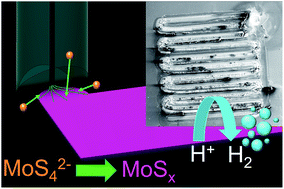High resolution electrochemical additive manufacturing of microstructured active materials: case study of MoSx as a catalyst for the hydrogen evolution reaction†
Abstract
High-resolution electrochemical additive manufacturing follows the principle of additive manufacturing (AM) in that new devices are constructed by electrochemically driven, localized and layered deposition of material. As for AM, an important limitation is the deposition of functional materials such as catalyst materials, which are mandatory for their incorporation into real electrochemical devices. As catalyst materials, transition metal chalcogenides attracted considerable attention due to their potential to replace platinum as a catalyst in the electrochemical hydrogen evolution reaction (HER). While considerable effort has been devoted to the preparation and engineering of 2D structures, their microstructuring is still a major challenge. Here, using MoSx as a functional material for HER catalysis as an example, we demonstrate that high-resolution electrochemical additive manufacturing leads to printing of microstructured highly active electrochemical devices. A one-step process for localized electrochemical deposition and microstructuring of MoSx with controlled chemical composition using scanning electrochemical microscopy (SECM) is demonstrated. The resulting materials were investigated by scanning electron microscopy, energy dispersive X-ray spectroscopy, X-ray photoelectron spectroscopy, and SECM. Practical applicability is demonstrated by large-scale printing and investigation of their performance as catalysts for energy conversion using linear sweep voltammetry. This method of high-resolution electrochemical additive fabrication of active materials will have wide application as it can be extended for the deposition of active materials on any conductive surface.



 Please wait while we load your content...
Please wait while we load your content...